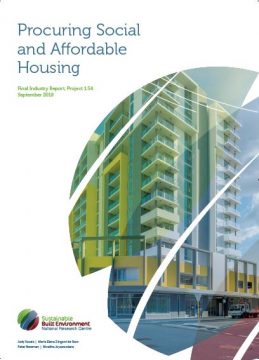Improving the suitability, supply and provision of housing infrastructure is needed to address current issues of affordability and access. In particular, the current severe shortage of social and affordable housing means that governments and others are struggling to find the resources to meet needs and demands. Recent SBEnrc research focussed on how access to safe and secure housing delivers a considerable positive impact to individuals, including improved health and well-being, better access to employment, and stronger communities. This in turn delivers broader productivity benefits to society. Improving access to housing and associated support services needs to be addressed through new and innovative approaches. Better aligning social benefits with delivery through innovative procurement strategies will be examined in this research, to address the balance between objectives along the housing supply chain.
Objectives
This project, through partnering with government agencies, not-for-profit providers and residential builders and contractors, aims to address key challenges and identify procurement-based best practices. Key steps in this project (and associated deliverables) include:
- A review of literature to address issues associated with changing housing typologies and demographics in Australian states, especially Western Australia (WA), Queensland (Qld) and New South Wales (NSW).
- A summary of Australian procurement approaches by jurisdiction. This will initially focus on WA, Qld and NSW but may be extended to Victoria and South Australia.
- A summary of of relevant international procurement approaches, with the primary focus on current research in Canada, the USA and the UK. A limited review of European Union countries may be undertaken, pending resources.
- The development of a set of criteria for analysis of social value procurement approaches. A 360 degree survey of social and affordable housing stakeholders (including heads of government delivery agencies, developers, architects, planners, financiers and service providers) will inform this, with recommendations to ‘find-the-best-fit’ in optimising the investment risk equation and aligning the benefits.
Industry Outcomes
Effective communication of the findings will be achieved through the project’s industry partners and allied associations, and include:
-
- An understanding of how housing needs will change over the next 20 years, identifying key challenges, the changing typologies of housing, such as villages and self-sustainability, and the relationship to other social measures, for example security, health and connectedness.
- Better mechanisms to address/deliver social value whilst at the same time addressing risk profiles for those delivering both asset and service-based outcomes, through comparing, contrasting and reviewing different forms of current procurement approaches to social housing from the viewpoint of various stakeholders and across various jurisdictions.
- Recommendations on how to optimise procurement frameworks to highlight best-practice delivery of social housing and access to affordable housing; for example through improved procurement efficiency which provides clarity, consistency and transparency around social value delivery.
Documents for Downloading
The following documents provide additional detail regarding this current research, including project outcomes to date:
Project 1.54 Fact Sheet (24 March 2017)
Previous research
Valuing Social Housing (2015-2017)
Rethinking Social Housing: Effective, Efficient & Equitable (2014-15)
Industry Report
Procuring Social and Affordable Housing (5Mb, November 2018)
Research Reports
Social Procurement Criteria (2Mb, October 2018)
Social Procurement Approaches (1Mb, February 2018)
Changing Demographics and Typologies Report (3Mb, December 2018)
Funding and Financing Report (1Mb, May 2018)
Procuring social and affordable housing in Australia – 360 degree survey findings (2Mb, July 2018)
Publications
Presentations
Social procurement criteria: Building the case for housing as infrastructure, AHURI National Housing Conference, 29 August 2019 (1Mb)
Leveraging procurement for social benefit: social procurement criteria, National Sustainability Conference, Brisbane, 1-2 April 2019
SBEnrc Social Housing Research – 2014 to now, presented at QShelter State Conference, Brisbane (2Mb, 1 June 2017)
Procuring Social and Affordable Housing: Changing demographics, updating typologies, & aligning social procurement criteria, AHURI National Housing Conference – Think Tank Session, 30 November 2017 (2Mb, November 2017)
Changing Demographics and Housing Typologies: Addressing Social and Affordable Housing in Australia, Joint Asia-Pacific Network for Housing Research and Australian Housing Research Conference, 6-8 June 2018 (1Mb, June 2018).
Valuing Social Housing & Procuring Social and Affordable Housing, SBEnrc Boardroom Briefing, Brisbane (1Mb, May 2017)
Academic Papers
Changing Demographics and Housing Typologies: Addressing Social and Affordable Housing in Australia, Joint Asia-Pacific Network for Housing Research and Australian Housing Research Conference, 6-8 June 2018 (1Mb, June 2018).
Media
Article – European Network for Housing Research Newsletter, SBEnrc Social Housing Research Update – Page 16 (February 2017)
Article – Livable Cities Website: Valuing Social Housing (September 2017)
Article – HousingWORKS journal, Procuring Social and Affordable Housing (March 2018)
Shelter WA Newsletter (18 January 2019)
Article – Procuring for productivity Property Journal, RICS Procuring for Productivity Property Journal (October 2019)
Videos
Full Video: Procuring Social and Affordable Housing: Improving Access and Delivery, October 2018 (6:41)
Project Summary: Procuring Social and Affordable Housing: Improving Access and Delivery, October 2018 (2:25)
Related Reports
Social and Affordable Housing Symposium Report, Griffith University, Brisbane, 25 September 2017 (2Mb) – Link to Papers





